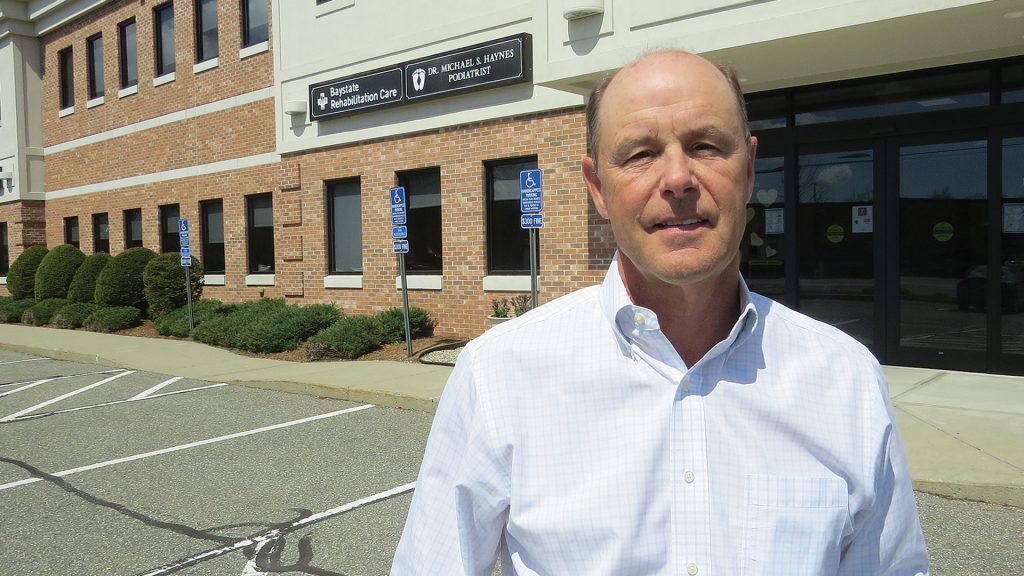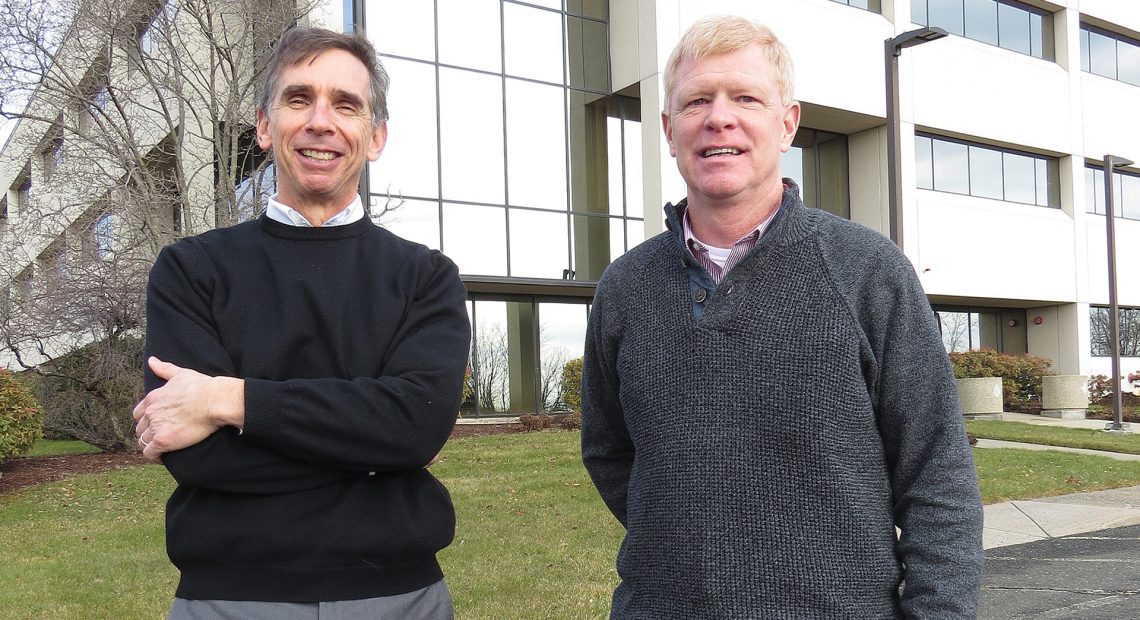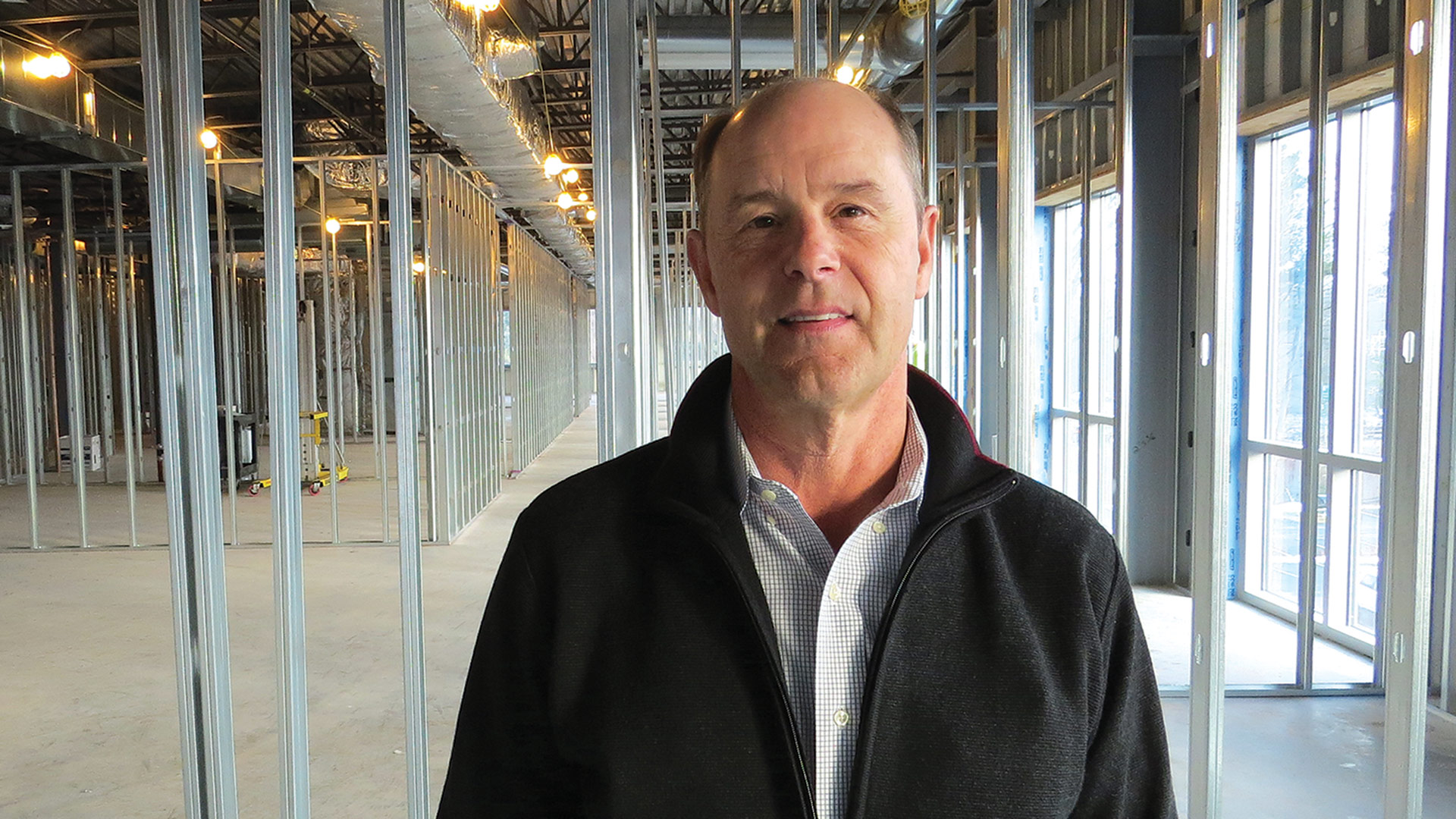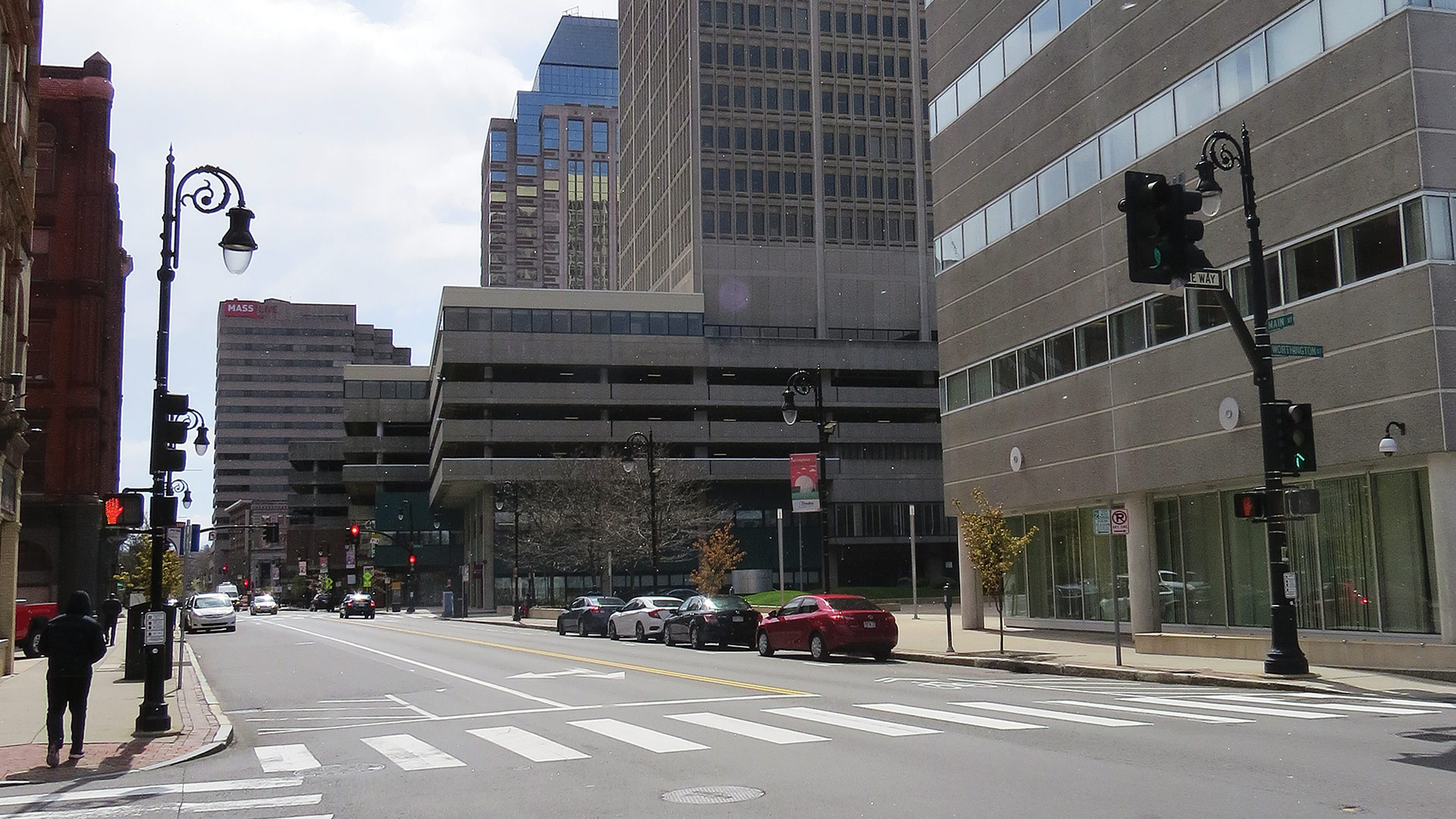Activity Report

Mitch Bolotin, left, and partner Kevin Morin stand near the entrance to 11 Interstate Dr. in West Springfield, which recently welcomed a new tenant, Millipore Sigma, which absorbed 27,000 square feet in the office building.
Looking back, area commercial real-estate brokers, managers, and developers said 2021 was a busy year with activity across all sectors and especially the retail side and the white-hot industrial segment of the market. On the office side, there was less movement and more question marks due to COVID-19 and uncertainty about when and under what circumstances workers will return to the office. The expectation for 2022 is for more of all of the above.
Area commercial real-estate brokers, developers, and property managers spoke with one voice when they told BusinessWest that there can be activity in their sector — and sometimes lots of activity — even when the economy is not hitting on all cylinders.
And this fact of life certainly helps explain why most brokers said 2021, year two of the pandemic, was one of the busiest years they’ve seen recently.
Indeed, there were some business closures and companies moving on from their leases, said those we spoke with, and other businesses downsizing for one of many reasons — all of which created movement in the market.
But there were many other forces contributing to this movement, and most of them were positive, said Mitch Bolotin, a principal and vice president of Springfield-based Colebrook Realty Services.
Listing them, he noted everything from low interest rates to the continued growth of the state’s cannabis industry, which has been absorbing industrial and retail space in communities across the region; from the improved health of the manufacturing sector, which has also contributed to the white-hot market for industrial spaces (more on that later), to the continued growth of delivery and warehousing operations, which has created ever more demand for those spaces. There’s has also been a noticeable increase in the amount of entrepreneurial activity in the region, inspired in part by COVID-19, which has created interest in retail space and some of the restaurants that have fallen victim to the pandemic.
“There is going to be some creative reuse of office space, and retail space, in this region.”
“This past year was one of our busiest years, and there was a lot of activity on all ends of the marketplace,” Bolotin said. “We’ve had deals in the retail world, the industrial market has been very active, the office market has been active, and there have been some development deals. We’ve seen it all across the board.”
Evan Plotkin, president of Springfield-based NAI Plotkin, agreed, noting that some of the movement on the retail side and office side has been as a result of COVID and its ill effects, but there has been positive movement as well, especially on the industrial and multi-family residential sides of the ledger, where the laws of supply and demand have forced prices higher as competition for available properties escalates.
There has even been some movement in the office market, said those we spoke with, but overall, this is the category still clouded by question marks. Large question marks.
Indeed, while all those we spoke with expressed the opinion (and we’ll paraphrase) that many workers now toiling remotely will eventually return to the office because employers realize there is more and better collaboration and more productivity when a team is in one place, there was also something approaching general consensus that things won’t be like they were before the pandemic.
And this means that some office space — just how much comprises one of those question marks — must be repurposed.
“There is going to be some creative reuse of office space, and retail space, in this region,” said Ken Vincunas, president of Agawam-based Development Associates. “I don’t know want it’s going to be or who is going to do it, but the malls and some office buildings are going to turn into something that no one foresaw, something they weren’t designed for.”
Paul Stelzer, president of Holyoke-based Appleton Corp., which currently manages more than 2 million square feet of property in the region, agreed.
Citing a movement to convert large amounts of office space to lab facilities in Boston, Cambridge, and Worcester to feed a biotech sector ravenously hungry for space, he said this might be one possible course for Western Mass. … if it can attract workers for that sector.
“We need to look at how we can maybe take two floors of a building that might never be leased again and convert to some type of bio, some type of medical, some type of related spaces,” he said, “because when you talk about quality of life, we have an incredible quality of life here in Western Mass., and I think there’s some desire for people not to be going up and down a 30-story elevator every day or taking the subway to work.”
For this issue, BusnessWest talked at length with area brokers and property managers about the current scene and what they project for the future, both short- and long-term.
Moving Story
As he talked about the commercial real-estate market and the year that was, Bolotin said there was considerable movement across the region — and in all sectors.
And he pointed to properties Colebrook handled in 2021 — and is still handling in many cases — as evidence. The portfolio includes:
• The leasing of 27,000 square feet at 11 Interstate Dr. in West Springfield to Millipore Sigma. The company, a life-sciences R&D firm and subsidiary of Merck, was in a small office in Wilbraham and expanded into the space;
• The sale of the industrial property at 2024 Westover Road in Chicopee, one of many such properties that saw considerable interest, went fast, and sold for a good price;
• The successful leasing of the property at 95 Elm St. in West Springfield, formerly home to United Bank. The large office complex is home to a broad mix of tenants, including Tandem Bagel;
• The sale of 100 Water St. in Holyoke, a large former mill complex, to GFI, one of the many cannabis companies that now call Holyoke home;
• The sale of 5 South Maple St. in Hadley, once a PeoplesBank branch, a sign of continued movement in the retail market;
• The sale of the former Troy Industries property on Capital Drive in West Springfield; and
• The sale of the 68,368-square-foot, fully leased warehouse space at 87-147 Avocado St. in Springfield to Woodrow Studios LLC, a deal that closed roughly a month ago. “That’s an example of an industrial investment property that had a strong amount of activity,” Bolotin said.
Collectively, these transactions speak to those many forces mentioned earlier — everything from the cannabis sector to tremendous growth of warehousing, distribution, and delivery businesses to growth within the manufacturing sector — that made 2021 one of the busiest years the company has seen recently.
“And 2022 is shaping up to be more of the same,” he told BusinessWest. “There’s a lot of demand, a lot of positive activity; we see the market being resilient, and, overall, there is a good deal of optimism.”
Plotkin agreed, citing his company’s portfolio of activity in 2021 as more evidence of what has been happening, even with some sectors struggling to fully recover from the pandemic and its many side effects.

Paul Stelzer
“We need to look at how we can maybe take two floors of a building that might never be leased again and convert to some type of bio, some type of medical, some type of related spaces, because when you talk about quality of life, we have an incredible quality of life here in Western Mass., and I think there’s some desire for people not to be going up and down a 30-story elevator every day or taking the subway to work.”
On the industrial side, the company handled the sale of a large property in South Deerfield being leased by Yankee Candle, and Plotkin said it continues to receive calls from companies actively seeking warehouse or light manufacturing space with highway access in Springfield and surrounding towns.
On the retail side, it handled a number of transactions, from the former Hafey Funeral Home in Springfield to the former Manchester Hardware store in Easthampton to the Golf Acres recreational facility in Westfield. It is also negotiating the sale of a large shopping center in Pittsfield. There has been less activity on the office side, but the company did handle the sale of 480 Hampden St. in Holyoke to Girls Inc., among other deals, and has handled several leases and a few sales for companies reorganizing or downsizing space.
Overall, the two sectors seeing perhaps the most activity are retail and industrial, said those we spoke with, with cannabis impacting both in a positive way, although there are other factors as well.
Pat Goggins, president of Goggins Realty in Northampton, said the cannabis sector has certainly helped that city’s downtown, one that has seen several stores close due to the retirement of long-time owners, but also complications from COVID. But there have been other types of entrepreneurial activity, including some new restaurants and clothing stores.
Overall, he said it was certainly a much more “nervous time” in Northampton a year or so ago as vacancies started piling up in and around the downtown in a way that hadn’t been seen in decades, and there was uncertainty concerning when and under what circumstances those vacancies would be filled. Now, with many of those storefronts leased or under contract, including the Silverscape Designs property, there is far more stability.
“We’re making some nice progress in the level of activity that we’re seeing downtown, and it’s something that more closely mimics what we had been accustomed to,” he said, adding that, while there are still some vacant storefronts to be addressed, the overall tone is much more positive than it was a year or 18 months ago.
Plotkin agreed, noting that, overall, while retailers are seeing increasingly higher volumes of online sales, most of them still need a bricks-and-mortar presence, and this is contributing to ongoing movement in that segment of the market.

Ken Vincunas says the market for industrial properties is white hot, with immense competition for available properties pushing prices higher.
“They may shop for something online, but they want to go to the store to try it on,” he explained. “And that’s why I believe retail will remain strong.”
But it is the industrial market that is seeing the most activity, said Bolotin and others — and it would see considerably more if there was inventory.
At present, there isn’t much, said Vincunas, noting that what exists generally goes quickly and at high prices, which makes this category much like the residential real-estate market (see story on page 6).
“The industrial market has very little inventory, and for the few things that come up, there are a lot of takers, and the pricing has increased significantly, because people have products that people want, they’re making money, and they need that new building,” he said. “There’s been a lot of demand, things don’t stay on the market for long, and prices are way up.”
“There’s a lot of demand, a lot of positive activity; we see the market being resilient, and, overall, there is a good deal of optimism.”
As just one example, he cited the former home of Work Opportunity Center in Agawam, an 18,000-square-foot industrial space, which was under contract just a few weeks after it went on the market. Many other properties have moved in similarly quick fashion, and at prices — and here’s another parallel to the residential housing market — that have prompted buyers to also become sellers.
“We’re actually selling properties, which we hardly ever do, because the pricing is so high that you have to take some chips off the table and reposition the properties you want versus the ones that are in your past,” Vincunas said, noting that the company is in the process of selling a multi-tenant property in Chicopee.
“The price seemed right, and we thought it maybe it was time to change that in for something else,” he explained, adding that many property owners are thinking along similar lines to take advantage of the white-hot market.
Space Exploration
As noted earlier, it’s the region’s office market that has perhaps struggled the most, and it’s the one confronting an uncertain future.
Vincunas, whose company manages several office facilities, including the Greenfield Corporate Center, said the past 23 months have been a struggle on many levels, especially as companies find new ways to do business, with many employees working remotely.
Like others we spoke with, he believes employers will eventually bring workers back the office, for reasons involving productivity, communication, efficiency, and other factors, and when that day comes, the market will see a surge in activity.

Pat Goggins
“We’re making some nice progress in the level of activity that we’re seeing downtown, and it’s something that more closely mimics what we had been accustomed to.”
In the meantime, this will remain a tenants’ market, with many of the companies looking to downsize or just reduce their monthly rent expenditure finding landlords willing to make attractive deals, another trend that is expected to continue into 2022 and perhaps beyond.
As for the longer term, those we spoke with said that some (again, how much remains to be seen) of the traditional office space in the region will need to be repurposed, and it is incumbent upon those who own and manage it to start looking at viable options.
Stelzer noted that biomed is simply one of many possible alternatives.
“We have to do a really good job moving forward of cataloging what we have available, what we can pivot, what’s available for us, what the economic-development agencies can push,” he said, “because the days of the 200-person call center or 300-person call center are probably gone.
“So we have to turn around and figure out where people have to congregate, and lab space is one of them,” he went on. “There’s also an incredible demand for social services and mental-health space, which is partly driven by COVID and partly driven by the large amount of funding available for it; you may see some of these nonprofits that would typically be in a class B space or in space that doesn’t work as nicely for them taking the plunge and coming downtown or coming to a class A building; they can afford to do it, and demand for their workers is high.”
Stelzer said he’s already seeing such movement at one of the properties managed by Appleton, the Technology Park at Springfield Technical Community College. One of its major tenants, Liberty Mutual, has moved out of most of its space in the park (47,000 square feet) — part of a larger movement to have employees work remotely — and new tenants that have moved in include Mental Health Associates and Clinical & Support Options.
Since almost the very beginning of the pandemic, Plotkin has noted that, in this region, where the office market has traditionally had a comparatively high vacancy rate, the additional stress from COVID will force some property owners to think outside the box and find new uses for their square footage.
For the building he co-owns, 1350 Main St. in Springfield, and others, he has proposed housing or perhaps a hybrid concept, what he calls a “remote-work hub,” a facility in which people would live and work.
“There would be a living space, something like a dormitory, but done in an upscale way, with a lot of amenities,” he explained. “And then you have a work hub. The idea is to have a living space and then a floor where you can lease an office, so you’re not working at your kitchen table.”
Whether the remote-work hub is the answer remains to be seen, he went on, adding that, from his view, it’s clear that something — and something imaginative — needs to happen within the office market, especially in downtown Springfield.
“We have to look at the half-million square feet of vacant office space that we have and examine how we repurpose and reposition that,” he went on. “We also need to look at what kind of help we need from MassDevelopment and the state to incentivize business owners — people like me — to take a building like 1350 Main St. and convert half of it to co-living space.”
Bottom Line
Looking ahead to the rest of 2022, those we spoke with said that COVID makes it difficult to project exactly what will happen. Stelzer equated the landscape in the sector to “shifting sands,” and said that, until the ground stabilizes, more uncertainty will prevail.
Overall, the experts are predicting more of the same for the foreseeable future, meaning this will continue to be a tenants’ market in the office realm, and the laws of supply demand will create more movement in the industrial and retail segments of the market.
And it means more hard thinking — and some action — when it comes to deciding what can and will happen within the office market.
In other words, it’s shaping up to be another busy year.
George O’Brien can be reached at [email protected]


















